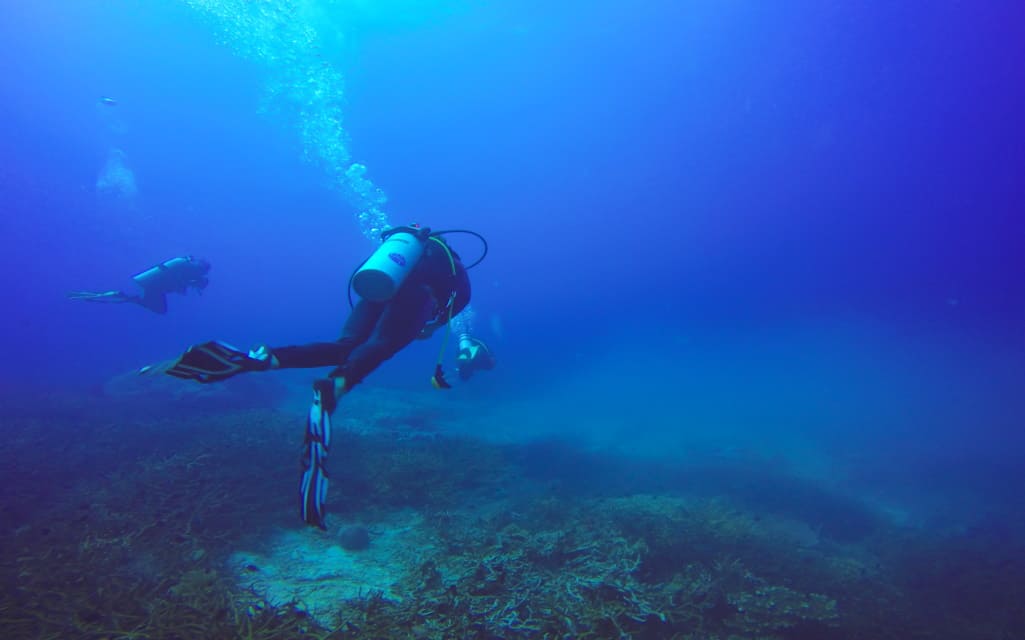Whether you’re new to the sport or have been scuba diving for years, the world of fins can be confusing. There are tons of styles to choose from, and a wide range of prices, too.
If you’re considering a new pair but don’t know where to start, don’t worry. This is your article!
We’ll walk you through a few key considerations that will help you pick the very best fins for your underwater adventures. And, we’ll explain it all in easy to understand terms. Keep reading to learn more.
Top Considerations for Finding the Best Fins
No matter which type of fins you decide on, the proper fit should be your top consideration.
To try fins on properly, slide them on over bare feet or dive boots depending on the style. Then, raise your heels one at a time off the floor. You shouldn’t feel your foot sliding around inside, or any rubbing and friction against your heel.
Take your time during this step. Poorly fitting fins might seem like no big deal on the surface, but they’ll likely lead to painful blisters and rub marks as soon as you hit the water.
Heel
Scuba fins come in two primary styles, open and closed heel.
Closed heel fins have a rubber foot pocket that slides over your foot just like a shoe. This style is best for snorkeling and warm water use, as it’s worn over a bare foot.
Closed heel fins are not designed for swimming in challenging dive conditions like current and surge. For these more difficult diving scenarios, you’ll want to use an open heel style.
Open heel fins use a buckle or spring strap to close around your heel. And, while some models can be used with bare feet, you’ll likely feel more comfortable wearing these with a pair of dive boots underneath.
Unlike closed heel fins, this style can stand up to difficult diving in cold water and less than ideal conditions underwater.
Weight
While it might sound funny at first, weight is a big deal when you’re shopping for dive fins.
Lightweight fins work well for warm water and calm conditions, like a tropical vacation. Plus, they double as snorkeling fins, making them an affordable choice for divers who don’t spend too much time in the water.
If you’re planning on doing a lot of dive travel, the weight will also be a vital consideration when it comes to packing your bags. Fins are bulky to begin with, and adding a ton of extra weight to your equipment can make flying a challenge.
Heavy fins provide more power in the water. That’s why you see so many divers using old school rubber models like force fins and jet fins.
If you’re planning to take on cold water, or tough conditions like surge and current, you’ll need that extra weight to help propel you.
A set of heavy fins can also help with buoyancy issues like poor trim and floating feet. These problems are most often experienced by female divers and can be worsened by thick exposure protection and wetsuits.
The heavier your fins are, the easier it will be to keep your feet from drifting up toward the surface!
Read More: 5 Diving Destinations That You Must Visit
Blade
When it comes to your fin’s blade, there are hundreds of design elements and special features to choose from. Flexible panels and channels, hanging loops, and rigid footbeds are all the rage. But, don’t let these details distract you from the blade itself.
The most common blade style is a solid piece of flexible material, often a blend of rubber and plastics. Solid blades offer plenty of power with less effort and are an excellent style for divers who need to kick hard in a current.
Solid blades are also less prone to damage than some other varieties, thanks to their rugged one-piece construction.
Vented blades use small holes to allow water to pass through them. This adds speed and agility, perfect for divers who need a little boost to keep up with the group.
Some divers also prefer a vented style if they plan to walk over long distances with their gear, like during shore diving. Vents can often double as carrying loops, making your equipment more portable.
Split blades are the least common style, but for some divers, they might be the most beneficial. A split blade is more flexible than its alternatives, adding to your range of motion underwater.
This activates a different set of muscles as you swim, reducing fatigue as well as pressure on the joints in your ankles, knees, and hips. If you ever experience aches and pains after diving, or if you have arthritis, this style might be your best bet.
Check out this helpful Aquazealots.com article for more details!
Find Your Perfect Fin
Now that you know a bit about the major design elements to look for, you’re probably excited to start shopping.
Don’t forget; you should always try fins on before buying them, to ensure proper fit. And, don’t get discouraged if you need to try a variety of styles before finding your best match.
It’s totally normal!
Combine a perfect fit with the features you want most to find the best fins for your next scuba diving experience. And, when in doubt, opt for a versatile and affordable style that will work in all the environments you’re planning to explore. If you found this article helpful, be sure to check out the rest of our blog. It’s packed with easy to follow tips for travel, lifestyle, and more!



